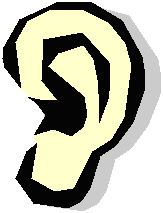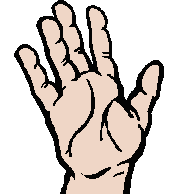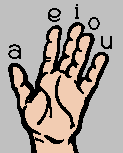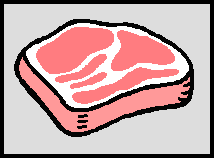

Let's get physical
Devising techniques for kinaesthetic learners





Visual
35%
Auditory
25%
Kinaesthetic
40%
Research suggests that as many as 40% of people have a kinaesthetic preferred processing mode. When we compare this to the predominantly oral methods that are employed in the majority of classrooms, there may be a clue as to why our teaching and training methods are not always as effective as they might be.
How can we engage kinaesthetic learners?
Wherever possible, we should allow, indeed encourage such learners to touch and feel, to become involved and to get their �hands on�! The list of subjects that lend themselves readily to experiment and role play, practice and participation is considerable. Various aspects of science, English, history, modern foreign languages, indeed most subjects, can be presented in a lively, participative way.
Often, the use of such approaches may be the only way to ensure that students develop their understanding of what is happening. However, we also have to acknowledge that there are certain aspects of some subjects that simply require memorising. Even here, a simple body-based memory-system (such as �Body-pegs�) can prove invaluable to students who cannot grasp the traditional (usually linguistic) mnemonics with which we provide them.
Working closely with schools in the Humber region, I have been keen to explore some of the ways in which we can facilitate the learning of those students whose preferred learning style is kinaesthetic. To this end, I have developed a number of simple techniques to aid memory and contribute to more effective learning. The criteria for such techniques are:
-
they are easily learned;
-
they have an obvious immediate application;
-
they can be applied by the students themselves.
This latter criterion is important if we are to encourage genuine learning skills in the students with whom we work. Many of us have benefited in the past from having teachers who helped us overcome our own learning difficulties by supplying us with simple (or sometimes quite complex) mnemonics. This is all very well, but it does mean that students are limited to the fund of hints and tips accrued by their teacher or generated by the teacher�s creativity. However, if we teach the students how to apply the techniques for themselves, the only limitation is the combined creativity of the whole class! It also means that we are developing their independence as learners.
One such activity takes only minutes to learn, not much longer to consolidate and has a host of useful applications. �Finger vowels� is based on the British Sign Language finger-spelling alphabet, in which pointing at each finger (usually of the left hand) represents a vowel.
PLEASE NOTE: The vowels are represented differently in American Sign Language, hence the following technique would need to be significantly adapted to be of use in USA � unless teachers were happy to use the BSL vowel signs.

There are a number of simple and enjoyable ways to consolidate students� learning of the �finger vowels�. One such method is to play a simple classroom game in which the teacher calls out vowels one at a time. Students respond by repeating each vowel in unison and thrusting the appropriate finger skyward. The teacher gradually increases the pace of the game until the entire class has tied itself in knots! It is important that the learning process is non-threatening and stress-free, hence the emphasis on the use of games and similar fun activities.
I have devised various games which use the �finger vowels�. These have been designed to familiarise students with the �finger vowels� activity; to encourage observation of vowel use; and to extend understanding of the use of vowels. Click here for "Vowel-picker" and "Vowel-spotter"
An immediate application for this particular activity is that it provides a simple method of remembering spellings � which really needs to be seen in order to appreciate its simplicity.
Consider homophones: those words that sound the same but are spelt differently. Students often have difficulty remembering which spelling relates to which usage. Visual learners may well be able simply to look at the words in order to differentiate them. Auditory learners may be able to recognise the component parts of the word and make relevant association. But what of the kinaesthetic learner, who struggles to learn the difference but finds themselves repeatedly frustrated? Enter �finger vowels�, which can be used as the basis of a simple physical mnemonic system.


Take, for example, MEAT and MEET. Students are encouraged to pick up an imaginary piece of meat, in an exaggerated fashion, between index finger and thumb, and place it daintily in their mouths. Then they mime two people MEET-ing, using the index fingers of each hand to represent the people. As teacher and students repeat each action, the teacher points out that MEAT (also written on the board) contains the vowels E and A, which are represented by the index finger and thumb (used in the mime to pick up the meat) � whereas MEET contains E and E, represented by the two index finger �people�. The students are encouraged to perform the action again as the teacher repeats the association � though there is hardly any need to do so, as most students have already made the connection.
Similarly, HEAR and HERE can be readily associated with simple mimes. Students grasp their ear-lobes with finger and thumb � or point emphatically at the ground using both index fingers.
WEAR and WHERE, THERE and THEIR, SEE and SEA all succumb readily to such treatment, as do a great many other homophone pairs. Indeed, once students have got the bit between their teeth, they are keen to devise a host of such mnemonics. All it takes is a grasp of the basic technique � and a little imagination.
Having learned the vowels, it is a short step to learning the entire sign language alphabet. From my experience of working with Year 5 & 6 classes (9 � 11 years old), this need not take more than 20 minutes initially. If this is revised three or four times during the following weeks (for only 10 minutes each time), students soon become quite adept. With the whole signed alphabet at their disposal, students need not restrict themselves merely to learning how to differentiate homophones. They can now branch out to learning unusual spellings, either in whole or in part, forming their own physical reminders. I have been encouraged, and sometimes quite astonished, by the ingenuity of students in devising and recalling their own mnemonics.
Of course, the system does not suit everybody and it is important to stress that it does not matter if students have difficulty learning the signs or using the system. This is just one more strategy to assist the learning process; it is neither the only one nor an essential one. If students experience difficulty with the techniques, it is probably because they are visual or auditory learners and they can just as easily resort to more traditional methods. If, on the other hand, it is a technique with which they feel comfortable, then students will have been enabled to take one more step towards becoming truly effective (and independent) learners.
SEE ALSO: VAK learning styles
SEE ALSO: Physical Intelligence
SEE ALSO: Drama across the curriculum
